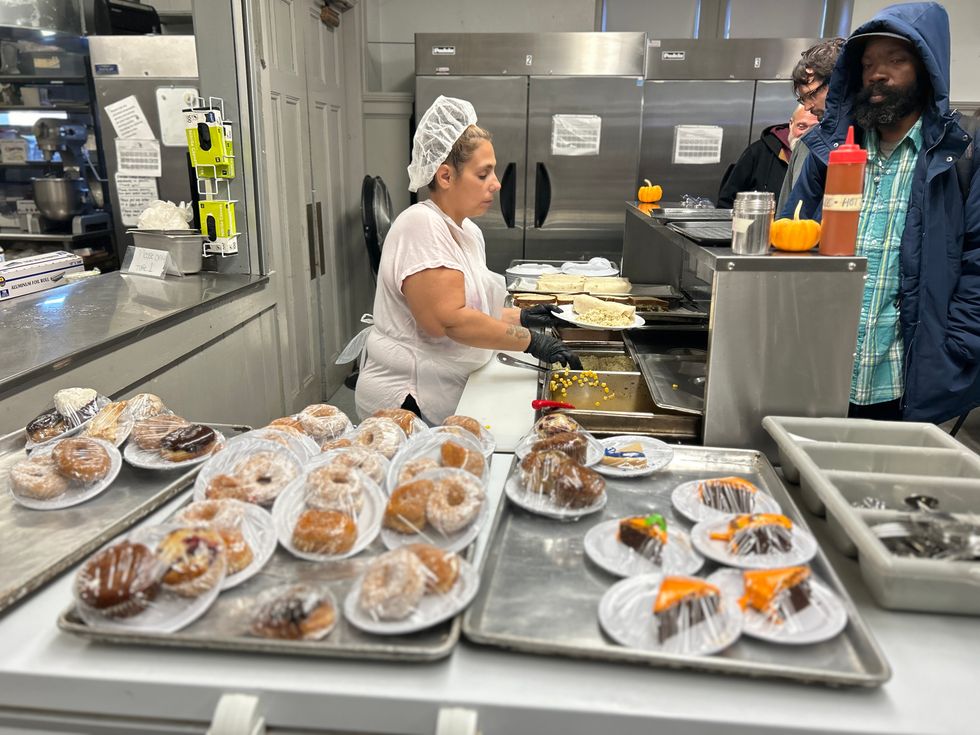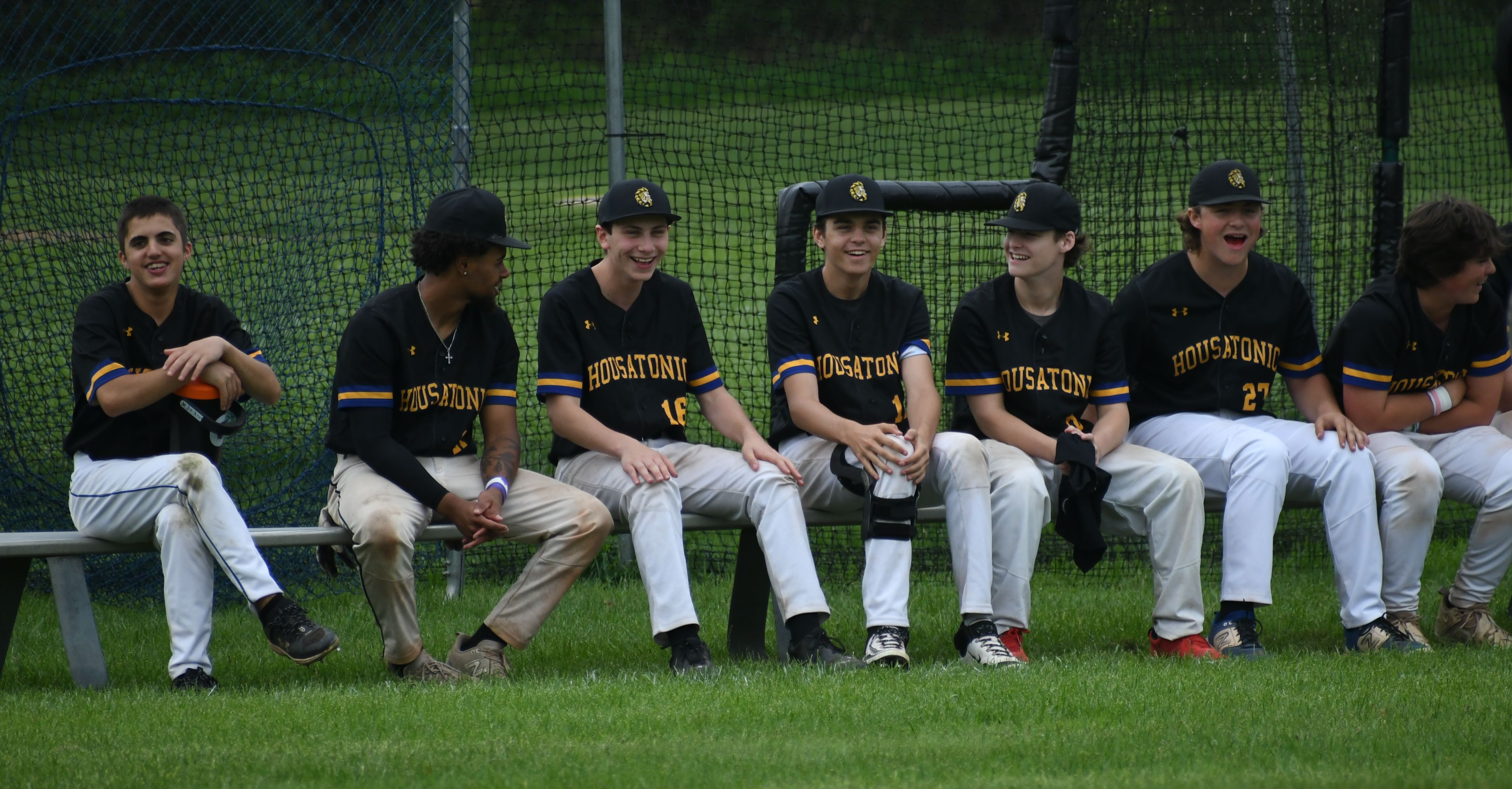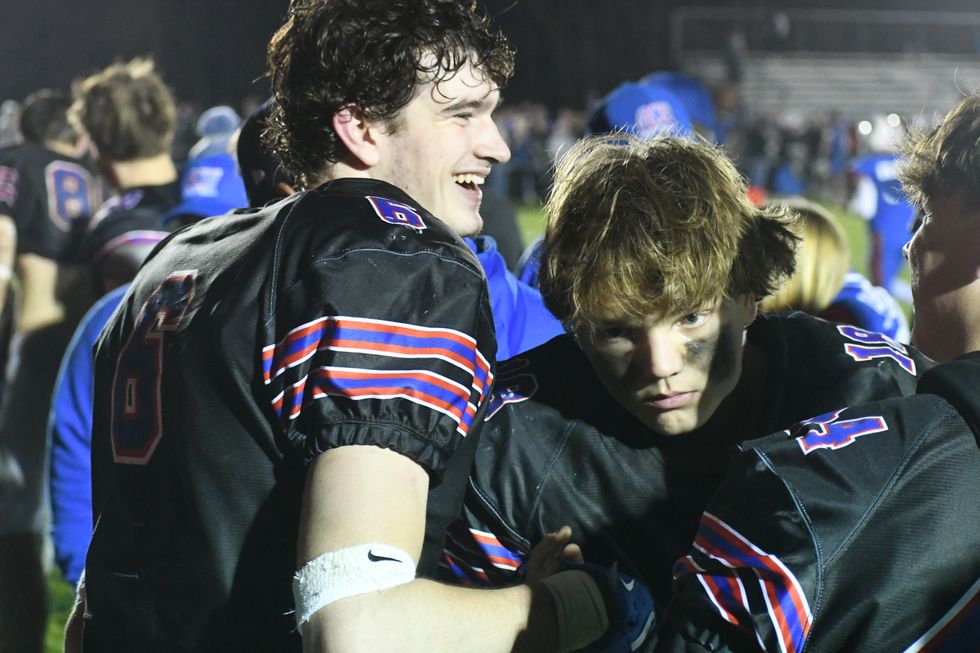We gather together: A homeless family’s story

Cristina and Kayla Garcia shared their story with The Lakeville Journal Nov. 19.
Jennifer Almquist

Cristina and Kayla Garcia shared their story with The Lakeville Journal Nov. 19.
Here in the Northwest Corner of Connecticut, where the first frost comes early, and black bears hibernate, the woods are inhabited by hundreds of people sleeping rough.
There has been a 14% rise in homelessness in Connecticut since 2022. There are now 482 “people in need of homeless response systems”, according to Connecticut Coordinated Access Network (CAN), many of them senior citizens.
Cristina and Ricardo Garcia asked a simple question, “Why is there no place in the world for us?”
The Garcias, with their 22-year-old daughter Kayla, are a family who spend each night sleeping in a tent city in Waterbury. They take a bus in the morning to the Gathering Place in Torrington for warmth and showers, then eat their meals together at the Community Soup Kitchen in town. Their fierce desire to stay together as a family has its genesis in years of suffering, deprivation, substance abuse, prison, and escape.
Family is all that matters to them. It is all they have.
“My daughter is shy, so speak quietly to her,” Cristina whispered, explaining further that Kayla and her sister Jessica, who is 18, are on the autism spectrum. Cristina and her girls escaped years ago from her abusive husband. Her girls were then taken from her when they were 12 and 14. Cristina, who has been clean for two years, suffered from substance use disorder. It has been six years since Cristina has seen Jessica.
Her daughter Kayla, her long braids tucked under a watch cap, was wearing headphones to mask out loud shouts of men heatedly discussing the mistreatment of criminals. Kayla’s expressive brown eyes gave away her discomfort. The homeless resource center was packed with women and men in from the November cold; some on cellphones, some waiting with their towels for a warm shower, others quietly sipping hot coffee.
The Gathering Place in Torrington is a daytime drop-in center for the 482 homeless neighbors who live in Litchfield County, Connecticut. The food pantry at Friends in Service to Humanity (FISH) in Torrington serves more than 2,000 people.
There are currently 51 shelter beds in Northwest Connecticut: 16 in Winsted and 35 in Torrington with 5 restricted to veterans. As of today, there will be 30 overflow shelter beds for the winter season.

At the Community Soup Kitchen in Torrington’s Trinity Episcopal Church Nov. 19, Cristina folded her family’s laundry on the table she had just cleared from the breakfast crowd. She paused to talk and reflect on her difficult journey.
Cristina Garcia: My husband Ricky just started working. He’ll be coming home with literally $72. a week. Sometimes I feel like no one cares. We’ve been clean for two years. We’ve had our ups and downs with our kids. My adoptive mom passed away and my dad passed away in a housefire. So, I don’t have any family. I had an abusive relationship basically, which I escaped with my daughters because it was very bad. My new husband Ricky and I met here, and we’ve been together for almost four years. Because of my earlier situation, my kids were taken from me.
Jennifer Almquist: How old were they when they were taken from you?
CG: They were taken away for six years when Kayla was 14.
JA: During that time were you allowed to have any communication, or hear how the girls were doing?
CG: Like I said, I was in an abusive relationship, and he was in charge. Kayla came back to me last January. It was rough. It is hard when you have no family, nothing to fall back on. Family is just me, my husband and my kids. Now there’s the Gathering Place, and the soup kitchen people that I consider family. They open their arms to us and have been very good, very kind to us.
JA: Did you have housing at some point?
CG: I did, but I lost my housing voucher because I was out of the household for over 20 days. I was incarcerated due to charges from five years ago. I was legally married, but they wouldn’t take in consideration the impact on the girls. The rent was still being paid - it was still being paid the whole time but they took the voucher away. So now it’s like, “do you have a lawyer - somebody to step forward?” Nobody comes forward. We didn’t appeal. We lost everything, so altogether we’ve been out on the street since I got out, so in and out, trying to keep the apartment, but we got notice from the city to quit the apartment, so now we’re on the streets.
JA: Do the charges on your record mean you have to start all over again to get a housing voucher?
CG: We’re just hoping for another voucher.
JA: Is that a lot of pressure when you are trying to stay straight?
CG: It is great to keep my mind straight by volunteering at the Soup Kitchen. When we first started coming here, my husband and I kept telling the boss DJ, if you guys need help, just let us know. You’re helping us out by giving us breakfast, giving us lunch. Suddenly one day the foundation that helps them provide the food wanted to interview somebody that was coming here. Someone that could explain to them the impacts, and how welcoming it is here. They interviewed me, and since that day I’ve been volunteering here. I basically go to the Gathering Place in the morning, take the shower and do laundry, come straight here by 9:30. From that time until around 2:30 I work in the kitchen and prep and serve food. I like it because it’s community. I love being here just because they are so kind to us. My daughter has a hard time talking to new people or getting to know new people. She has a close relationship with someone here now.
JA: What was her living situation when you weren’t with her?
CG: Kayla and Jessica were in foster care. I had no access to anything. Now it’s like starting all new, trying to apply for Social Security, Kayla’s been denied numerous times, and getting a copy of her birth certificate is expensive. That’s what I’m going through right now. She needs help. They say “we can’t help” because they don’t think she has that many issues because she doesn’t hear voices, and she’s not, in their minds, crazy like other people. Kayla does have mental health issues. Jessica didn’t start talking until she was six. It’s just sad that people don’t take in consideration what the impact of situations like being in foster care, or being homeless, are on kids. Especially if you’re a sensitive kid. Kayla is 22 but her mentality sometimes isn’t like her age.
JA: How does Kayla do with the sleeping arrangements and the cold?
CG: No, it’s horrible. All you just have is a tent in the world. People take your stuff; you can’t trust anybody -that’s just how it is. We have a small U-Haul as a storage unit that is expensive. We had to get rid of most of our stuff. It’s just hard, really hard especially with the holidays coming up.
JA: How do you three get warm in your tent?
CG: We layer up with four blankets on, then jackets and sleeping bags. Ricky puts a wooden pallet under the tent, but it’s like sleeping on the floor.
JA: What are you doing for Thanksgiving?
CG: The soup kitchen is not open on Thanksgiving. When you’re homeless you don’t get a break, you don’t get time, the days are endless. Holidays are just another day, not like anything special. We can’t plan anything. We have no way to cook anything. Every day in the woods, it’s just eating out of cans. We may not be able to have a Thanksgiving feast this year, but for Christmas, for my kids and my step kids, there’s no hope of getting them something special. Sometimes I just feel like I’m screwed. I just feel like as much as I try, it’s like I’m trying for what is not possible. It’s hard to keep hoping. These holiday times hurt the most. This is our first holiday back together in six years now that she’s back with us. I want am waiting until my youngest is 21 and graduates this June. For her to be allowed to come home, I must have housing. I feel like it might be a lot to ask, but I just want my family back together.
JA: What are you grateful for?
CG: Kayla loves her stepdad, and he’s very good to us. He walks up the mountain to work at Target. He walks because he can’t drive. We want to get him a bike. Hopefully by December the warming center will reopen. Lori at the Gathering Place helps us so much. She’s an amazing person. I had open heart surgery. They put in a pacemaker that needs replacing, but they can’t do the surgery and then discharge me to the street, so my surgery is being put off. I have seizures, so I need a calm setting. I’m grateful for Lori because she watches out for us. I have met amazing people through her, like the people in this kitchen, for DJ and Bill, and the opportunity to give back, you know. It’s important because I want to make sure I stay on track with my sobriety. Being around positive people helps me. I am trying not to cry. I want to have everyone together for Thanksgiving.
Housatonic Valley Regional High School's boys varsity basketball team won the Berkshire League/Connecticut Technical Conference Holiday Tournament for the second straight year. The Mountaineers defeated Emmett O'Brien Technical High School in the tournament final Dec. 30. Owen Riemer was named the most valuable player.
Salisbury’s Joel Blumert, center, is flanked by Linda Huebner, of Halifax, Vermont, left, and Trish Walter, of Collinsville, atop the summit of Bear Mountain on New Year’s Day. It was Blumert’s 1,000th climb of the state’s tallest peak. The Twin Lakes can be seen in the background.
SALISBURY — The celebration was brief, just long enough for a congratulatory hug and a handful of photos before the winter wind could blow them off the mountaintop.
Instead of champagne, Joel Blumert and his hiking companions feted Jan. 1 with Entenmann’s doughnuts. And it wasn’t the new year they were toasting, but Blumert’s 1,000th ascent of the state’s tallest peak.
The 76-year-old Salisbury resident has been hiking Bear Mountain twice a week, with only sporadic lapses, for nearly a dozen years. On New Year’s Day, Blumert reached the goal he set a few years ago of 1,000 climbs.
He has hiked it in the wintry cold and the summer heat, amid the splendor of the autumn foliage and even in the middle of a daunting tornado.

“It’s just been one step at a time and one climb at a time,” said Blumert, a musician who performs mostly at area nursing homes.
Blumert and his wife, Theresa Carroll, moved to Sharon in 1985 and to Salisbury in 1987, in part for the outdoor recreation the Tri-State region offers. But after their two daughters, Shayna and Denali, were born in the 1990s, Blumert’s exercise regimen started to lag.
In 2000, his doctor reported he had “ridiculously high blood pressure.”
“I decided if I was going to die of a stroke, it was better to die in the woods than sitting around the house,” Blumert said.
He began hiking again and rebuilt his endurance. In March 2014, he summited Bear Mountain, which at 2,316 feet is the highest peak in Connecticut. (The state’s highest point at 2,380 feet lies on the south slope of Mount Frissell at the border with Massachusetts.)
It was Blumert’s first hike up Bear in several years. As he gazed at the Twin Lakes shimmering below, he said to himself, “I love this mountain. I’m going to do this once a week.”
He grew to love the hike so much that after a year he doubled it to twice a week. Since then, Blumert has stuck to his weekly ritual with only occasional pauses for out-of-state trips or illness, along with one 13-week stretch when a pulled ligament in his pelvis planted him on the couch.
He knows the 2.9-mile route intimately, from the Undermountain trailhead off Route 41 to the intersection with the Appalachian Trail and on to the summit. In his sojourns, he has seen porcupines, deer, a timber rattler, a pair of copulating copperheads (“Or maybe they were milk snakes; I didn’t interrupt them to find out”), owls and redtail hawks — yet not a single bear.
Soon after he began hiking Bear regularly, Blumert made another vow: He would be cheerful and friendly to every hiker he met on the mountain. “I’ve developed trail friendships with 20 to 30 people,” he said.
One of them is Collinsville resident Trish Walter, who became a regular hiking buddy and has now climbed the mountain with Blumert about 70 times over the past five years.
Walter and her friend, Linda Huebner, of Halifax, Vermont, joined Blumert for his milestone hike on New Year’s Day. With 4 inches of snow having fallen the night before, they set foot shortly after noon and reached the top just before 3 p.m. The trek back down took half that time.
Aside from the blustery wind approaching the summit, they enjoyed a spectacular day of bright sunshine and blue skies.
The weather hasn’t always been so cooperative. Blumert was once nearly struck by lightning on the upper ridge. And this September, he hiked down in what he described as a tornado.
“It came right down Undermountain Trail,” he noted. “Trees were swishing back and forth. Branches were flying everywhere. There was grape-sized hail. It was scary.”
Now that he has reached his goal, Blumert plans to cut back to one hike of Bear each week. That will free time for other climbs in the area, a recumbent bicycle he has bought, and yet another mountaineering goal.
“I want to complete the 4,000-footers in New Hampshire,” Blumert said. “There are 48 of them, and I’ve done 23.”
Tessa Dekker, four-year basketball player at Housatonic Valley Regional High School, was named female Athlete of the Year at the school's athletic award ceremony in May 2025.
FALLS VILLAGE — From breakthrough victories to record-shattering feats, the past year brimmed with moments that Housatonic Valley Regional High School athletes will never forget.
From the onset of 2025, school sports were off to a good start. The boys basketball team entered the year riding high after winning the Berkshire League/Connecticut Technical Conference Holiday Tournament championship on Dec. 30, 2024.
Basketball games were well attended last winter thanks in part to the return of the Mountaineer cheerleaders. The squad performed halftime shows and coordinated themes for the audience, such as Hawaiian night.
“We made the themes really pop off,” said cheer captain Taylor Terwilliger.

The birth of a new Berkshire League rivalry emerged between HVRHS and the newly created Lakeview High School. The bleachers were packed when the girls and boys teams faced off back-to-back in Falls Village Feb. 5. HVRHS won the girls game 59-43, but Lakeview won the boys game 71-60.
At the end of the basketball season, Daniela Brennan was chosen to receive the Berkshire League’s Edward B. Kolakoski Sportsmanship Award.
The Housatonic co-op hockey team played its final game last winter. After the season, the co-op disbanded and this year HVRHS players are in a new co-op hosted by New Milford High School.

Players took to the diamonds come springtime for baseball and softball. In addition to high school teams, the Region One Middle School Mountaineers fielded teams for both sports.
Varsity baseball went on to earn a state tournament bid as the 21 seed. The boys played 12 seed Haddam-Killingworth High School in the first round and remained tied until a final inning walk-off win for HK.
Varsity girls lacrosse had a stellar season on the field and made it to the Western Connecticut Lacrosse Conference championship game. They ran into top-ranked Watertown High School and after a back-and-forth battle, Watertown won 6-4.

Track and field athletes made waves last season, breaking several school records and taking home 10 gold medals at the Berkshire League finals and festival. Sixteen Mountaineers represented HVRHS at the Class S state meet in New Britain and five went on to qualify for the State Open meet: Anthony Labbadia, Mia Dodge, Kyle McCarron, Gabi Titone and Ryan Segalla.
Labbadia’s performance in the triple jump earned him a spot at the New England track and field championships. His best distance of 44 feet and one inch stood for ninth place in New England and set the new HVRHS record. The previous school record of 43 feet eight inches was set by Don Hurlbutt in 1967.

Athletics continued into the summer with the Housy Hoops teams at the Torrington Summer Basketball League and the Housy Juniors in the Babe Ruth League summer baseball program. The girls basketball team became TSBL runners up after making it to the championship game against Lewis Mills.
When school started up in late August, fall sports swung into action beginning with varsity golf. Jonas Johnson went on to win the longest drive award at the Berkshire League golf all-star tournament Tuesday, Oct. 14.

Girls and boys soccer teams had historic seasons on the field and both qualified for the postseason tournaments.
The boys soccer team defeated Shepaug Valley High School for the first time in five years. The 1-0 win came in the Berkshire League tournament semifinals.
On the girls team, Ava Segalla set the new school scoring record with a total of 134 varsity goals. She surpassed the previous record of 120, which was set by her sister Sydney Segalla in 2021.
“Having scouts for the first time was definitely a very rewarding experience,” Segalla said. “It was exciting to see my hard work paying off.” Segalla committed to play Division I soccer at Sacred Heart University.
Girls soccer made a deep run in the Class S tournament, concluding with a showdown against Morgan High School in the semifinals. Morgan went on to become Class S champions.

HVRHS had three cross country runners medal at the BL championship Oct. 16. Olivia Brooks placed 11th, Hannah Johnson placed 17th and Finn Malone placed 18th.
Gilbert/Northwestern/Housatonic’s co-op football team was led in large part by the Mountaineers with eight seniors on the team. The team faced a top-heavy schedule and started the season 1-4. But they stayed disciplined and battled back to a 5-5 finish, concluding with a 34-0 shutout win in the Turkey Bowl.

“Out of the four years I’ve been playing, undefeated on Thanksgiving. No one will ever take that away from me,” said GNH captain Wes Allyn after the win.
Winter sports returned in December beginning with basketball. The girls team has a lot of young talent in new freshmen, and the boys team features a senior-heavy roster.
“I’m feeling very optimistic,” said senior captain Victoria Brooks. “Our strength is definitely going to be our dedication this year.”

Sharon Hospital, shown here, experienced a consequential year marked by a merger agreement with Northwell Health, national recognition for patient care, and renewed concerns about emergency medical and ambulance coverage in the region.
Housing—both its scarcity and the push to diversify options—remained at the center of Sharon’s public discourse throughout the year.
The year began with the Sharon Housing Trust announcing the acquisition of a parcel in the Silver Lake Shores neighborhood to be developed as a new affordable homeownership opportunity. Later in January, in a separate initiative, the trust revealed it had secured a $1 million preliminary funding commitment from the state Department of Housing to advance plans for an affordable housing “campus” on Gay Street.
That commitment was later doubled by the state, allowing the trust to break ground in September on a project that will renovate the long-defunct Community Center—once a Masonic Temple—into four additional affordable units. Those apartments will join six already occupied units in adjacent buildings, creating a unified, 10-unit development. The project cleared its final local hurdle in November, receiving approvals from both the Zoning Commission and the Historic District Commission.
Alongside those efforts, a more contentious proposal dominated Planning and Zoning Commission agendas during the first half of the year. A condominium development proposed near Sharon Hospital drew support from residents who favor a more diverse housing mix, while neighbors raised concerns about potential impacts on property values and quality of life.
The project, proposed by Gold Dog LLC, a private development company, was approved in August following months of heated public hearings. That decision, however, has since been appealed by opponents, ensuring that housing will remain an ongoing issue.
Health
It was a consequential year for Sharon Hospital, marked by major institutional changes, national recognition, and lingering concerns about access to care.
In May, Nuvance Health, the nonprofit operator of Sharon Hospital, announced that it had formalized a merger agreement with Northwell Health, one of the largest healthcare systems in the Northeast. The announcement raised concerns among some residents who feared consolidation could lead to reduced services at a facility that serves a region often described as a healthcare desert.
Hospital President Christina McCullough sought to reassure the community, emphasizing that the merger was intended to strengthen—not diminish—local care. “It’s not about cutting resources and cutting services,” she said. “It’s about optimizing what both of those organizations have, ultimately strengthening the access to care for everyone that lives in the community.”
In July, Sharon Hospital was the only Connecticut facility included on a national list of rural hospitals considered vulnerable to potential Medicaid cuts, underscoring the financial pressures facing small hospitals nationwide.
Despite those challenges, the hospital earned national recognition the following month. In August, Sharon Hospital received a national award for excellence in stroke care. Later in the year, it was awarded its sixth consecutive “Five Star” rating from the Centers for Medicare and Medicaid Services, placing it among just 290 hospitals nationwide to receive the distinction.
The year ended on a more uncertain note, however, when the hospital announced it would discontinue its longtime emergency response provider, Northern Dutchess Paramedics, effective Jan. 1. The decision raised fresh concerns among residents about the future of ambulance coverage and emergency medical services in the region.
Nature
Sharon’s connection to its natural environment remained strong throughout 2025, with residents, conservation groups and state officials engaging in efforts to protect local ecosystems and wildlife.
In April, local conservationist and invasive species expert Tom Zetterstrom addressed a packed Town Hall, outlining strategies to protect Sharon’s woodlands from invasive oriental bittersweet. Drawing on both successes and setbacks at the Sharon Land Trust’s Hamlin Preserve, Zetterstrom highlighted the urgency of sustained management and community involvement.
That same month, concerned residents formed the Mudge Pond Association in response to a December 2024 study that warned of imminent threats to the pond from invasive species and polluted runoff. Since its formation, the group has begun piloting protective measures and planning long-term stewardship efforts for the popular lake.

Conservation efforts expanded later in the year when the Sharon Land Trust partnered with the Northeast Wilderness Trust to secure Sharon’s first “Forever Wild” protected land. Announced in late summer, the designation places roughly 700 acres surrounding Sharon Mountain under a permanent conservation easement, safeguarding critical wildlife habitat from development, logging and motorized use.
Wildlife coexistence also drew attention in December, when the state Department of Energy and Environmental Protection hosted a community roundtable on living alongside black bears. Residents emphasized a “human behavior”-focused approach, advocating for changes in food storage and waste management rather than lethal controls.
Throughout the year, the Sharon Audubon Center remained active with public programs and education initiatives, culminating in its annual December bird count. The event connected local volunteers to a nationwide community-science effort to track winter bird populations.

Holiday season
The year closed with holiday traditions that underscored Sharon’s sense of community, bringing warmth and light to the darkest days of winter. Annual tree and menorah lightings, held five days apart in mid-December, brought luminance, song and joy to the snow covered Village Green in scenes that were classically Sharon.